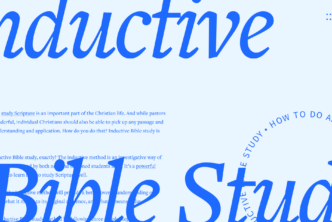The Bible can be a difficult book to interpret. Churches split over the interpretation of controversial texts, and many Bible readers feel bewildered about tough passages of Scripture.

In a way, this is a book designed for Logos users. Deppe an avid Logos user himself (he used Logos Bible Software as he wrote the book), and All Roads contains numerous examples of how to use Logos for exegesis and interpretation. So not only is this book vitally important for general readers, but it is especially beneficial for Logos users who are serious about understanding the text.
We were excited when Dr. Deppe took time out of his busy schedule to talk to us about All Roads Lead to the Text: Eight Methods of Inquiry into the Bible. What follows is the first half of a 2-part discussion.
Logos: Why did you write All Roads Lead to the Text?
Deppe: Interpreting the Bible can be frustratingly difficult for the average person. The eight chapters in this book equip the average reader with the methods scholars employ to interpret this historic book. The goal is that the reader will conclude at the end, “I too can read the Bible.”
Logos: How do you equip the reader to interpret the Bible?
Deppe: The book All Roads Lead to the Text functions as a template for model exegesis through an examination of: grammar, literary devices, structure, context, historical and cultural background, the history of interpretation, and the exegete’s presuppositions for interpretation. So really it is a book about exegetical methodology or hermeneutics.
What sets this volume apart from all others is the continuous use of biblical examples rather than an explanation of exegetical methods. Furthermore, I employ Logos Bible Software as I explore these biblical examples, so that students can perform their research more quickly and do not have to be close to a theological library.
Logos: You describe the book as a template for exegesis. How do you teach the process of exegesis?
Deppe: The best teaching methods employ memorable pictures. This volume compares the exegetical process to the use of various types of camera lenses so the reader perceives in a new way the importance of grammar, context, literary genre, historical background, structural analysis, and the history of interpretation.
Logos: Describe for us the flow of the book and the exegetical methods you employ.
Deppe: To fully understand the biblical text, we must place more than one lens on our exegetical camera.
The literary analysis of chapter one involves the employment of an infra-red lens to investigate what cannot always be seen in natural light. I demonstrate how the identification of unspecified genre and literary devices affect the final interpretation of a passage.
For grammatical exegesis in chapter two we employ an exegetical microscope which scrutinizes the details of a passage from words, to phrases, to clauses until we arrive at various translations of the text.
In chapter three we take a skeleton snapshot of the text so that we can envision the structure of the passage through developing a clausal outline.
Then, in chapter four, we avail ourselves of a wide-angled lens to probe the context before and after a particular pericope in chapter four.
In chapter five we utilize a telescopic lens and explore the world behind the text by inspecting the cultural and historical background.
Then, in chapter six, we roll out the motion picture exegetical camera in chapter seven to study the various periods of church history and to investigate how an examination of the major commentaries benefits our exegesis.
Next to last, chapter seven develops the finished photo through a theological analysis of the text and an exploration of the canonical meaning.
Finally, in chapter eight, we do not want to forget to explore the world in front of the text by an investigation of the reader’s presuppositions. We need to take an x-ray picture of ourselves so that we don’t subconsciously deceive ourselves and read our unexamined presuppositions into the text. Here I describe seven spiritual exercises and disciplines that enable us to apply the text to contemporary life.
These exegetical camera shots form a sample album of proofs that offer snapshots of the text from various angles. We discover that all roads lead to the text as the title of the book says.
Logos: What makes this book different from other books that interpret the Bible?
Deppe: What sets this volume apart from all others is the continuous use of biblical examples rather than an explanation of exegetical methods. Students and preachers want immediate application of theoretical methods. They want to know how a study of the grammar or structure of the text will make a difference. So in each chapter I include ten to twenty concrete examples of how the context or history of interpretation makes a difference in how you understand the Bible. Each description of a text consists of a couple of pages so the information is easily accessible yet sufficient in length to stimulate a good discussion.
Logos: Rarely does a volume include both scholarly exegesis along with a section on spiritual disciplines that will affect the reader in interpreting the text. What made you want to tackle these two together?
Deppe: The addition of a chapter on “Spiritual Exegesis” attempts to propose seven strategies in addition to the historical-critical method that affect interpretation and application. These spiritual disciplines include
-
- a practicing faith perspective,
- personalizing the text,
- praying Scripture,
- picturing concepts through meditation,
- listening prophetically,
- paradigm-building through mirroring, and
- imaginative application.
This x-ray of our personality, presuppositions, and spiritual makeup certifies that this whole process is not just an intellectual exercise completely separated from our life experience. Historical-critical exegesis stands at a crossroads where it must recognize and incorporate other methods into its field of vision. Our methods of interpretation must not only supply information but also personally form the reader, supply practical application, and connect the reader directly to God in deeper and more meaningful ways. That’s what I try to do in the last chapter.
Come back tomorrow for Part II of our discussion with Dean Deppe! And make sure to check out All Roads Lead to the Text: Eight Methods of Inquiry into the Bible for an opportunity to get it while it is still available at a great Pre-Pub discount.





